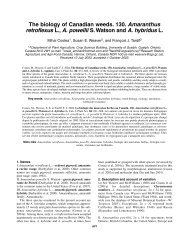The biology of Canadian weeds. 133. Cuscuta campestris
The biology of Canadian weeds. 133. Cuscuta campestris
The biology of Canadian weeds. 133. Cuscuta campestris
You also want an ePaper? Increase the reach of your titles
YUMPU automatically turns print PDFs into web optimized ePapers that Google loves.
300 CANADIAN JOURNAL OF PLANT SCIENCE<br />
Fig. 4. Distribution <strong>of</strong> <strong>Cuscuta</strong> gronovii (dots) and C. umbrosa in Canada (crosses). [ACAD, ALTA, DAO, HAM, MT, MTMG, NFLD,<br />
NSPM, NY, OAC, QFA, QUE, RBG, SASK, SFS, TUP, UBC, UNB, USAS, UWO, UWPG, WAT, WIN and WIS; herbarium abbreviations<br />
according to Holmgren et al. (1990)].<br />
these (see also Section 7a). <strong>Cuscuta</strong> <strong>campestris</strong> could not<br />
survive on Azolla caroliniana Willd., Equisetum arvense L.,<br />
Elaeocharis rostellata Torr., Atriplex spp., Amaranthus<br />
retr<strong>of</strong>lexus L., Portulaca oleracea L., Brassica nigra Koch.,<br />
Glycine max (L. ) Merr., Vicia villosa Roth., Lycopersicon<br />
esculentum, Arctium lappa L. or Tanacetum vulgare L.<br />
(Gaertner 1950).<br />
Parker and Riches (1993) distinguished primary and secondary<br />
hosts. Primary hosts are those plants on which<br />
<strong>Cuscuta</strong> spp. can establish from the seedling stage.<br />
Secondary hosts are those plants on which the seedling parasite<br />
cannot establish, but with which they can connect once<br />
the parasite has established itself on a primary host. For<br />
example, the primary host range <strong>of</strong> C. epilinum is limited to<br />
Linum spp., but once established on the latter, it can attach<br />
on other dicotyledonous species as well (e.g., Impatiens<br />
spp., Gaertner 1950). Plants from Poaceae and Cyperaceae<br />
are incompatible as primary hosts (Dawson et al. 1994), but<br />
Parker and Riches (1993) hypothesized that some monocot<br />
species may act as secondary hosts, at least for some<br />
<strong>Cuscuta</strong> spp. However, although <strong>Cuscuta</strong> spp. may twine<br />
around grasses, no haustorial connections were observed<br />
(Rath and Mohanty 1988; Dawson et al. 1994).<br />
6. History<br />
<strong>The</strong> history <strong>of</strong> <strong>Cuscuta</strong> parasitism during ancient and medieval<br />
times has been investigated by Costea and Tardif (2004).<br />
Several <strong>Cuscuta</strong> spp. (C. tinctoria L., C. americana L., C.<br />
odontolepis Engelm.) were used by the Aztecs to produce a yellow<br />
dye called “Zacatlaxcalli” (Sahagún 1950–1982).<br />
Apparently, different hues <strong>of</strong> yellow were obtained from plants<br />
<strong>of</strong> different ages: younger stems gave lighter hues while older<br />
stems produced bright yellows. Navajo Indians <strong>of</strong> the<br />
Southwestern United States gathered seeds <strong>of</strong> C. umbrosa and<br />
made them into soup or stew (Castetter 1935). Paiute Indians<br />
used <strong>Cuscuta</strong> spp. as a contraceptive, the plant being known as<br />
“woman without children” (Moerman 1977). Maidens <strong>of</strong><br />
Pawnee Indians used C. gronovii to determine the seriousness<br />
<strong>of</strong> a suitor: “A girl having plucked a vine, with the thought <strong>of</strong><br />
the young man in mind tossed the vine over her shoulder, into<br />
the <strong>weeds</strong> <strong>of</strong> host species <strong>of</strong> this dodder […]. <strong>The</strong> second day<br />
after she would return to see whether the dodder had attached<br />
itself and was growing on the host. If so, she went away content<br />
with full assurance <strong>of</strong> her lover’s sincerity and faithfulness”<br />
(Gilmore 1914).<br />
Gronovius (1762) mentioned first from Virginia a<br />
<strong>Cuscuta</strong> species with “floribus pedunculatis” and stems



